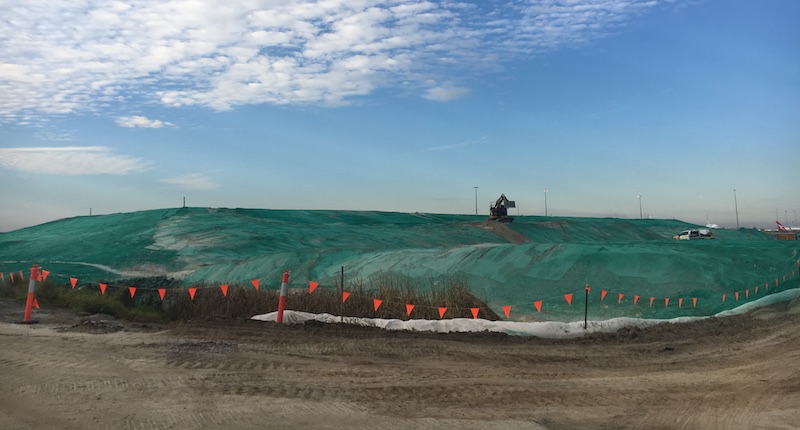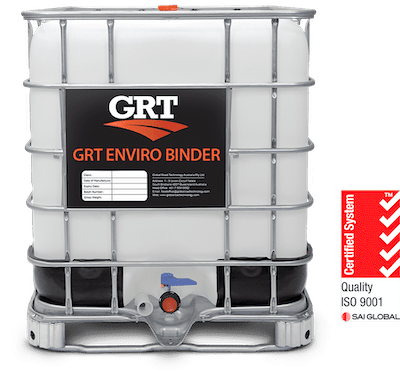Erosion is the moving of soil from one place to another by the activity of wind or water or physical disturbance (e.g. traffic, earthworks, or even livestock movement). In this way, the material can be transported a distance of a few millimetres or thousands of kilometres away. Effective Erosion Control Solutions stop both coarse and fine sediment from eroding, thus preventing unpredictable and undesirable movement of soil.
GRT’s effective erosion control solutions

Global Road Technology created a product that provides all desired properties of temporary erosion control solutions; it is effective against wind and precipitation water activities and provides optimal conditions for planting. This surface stabilizer product trademarked GRT Enviro Binder keeps soil in place and provides optimal soil porosity which is very beneficial for plants growing. Using GRT erosion control solutions has the following incentives:
- Non-toxic and environmentally friendly product.
- Immediately effective once applied.
- Binds soil preventing impact and sheet erosion on any exposed soil area.
- Support seed and vegetation growth.
- Minimal soil preparation for application of the product.
- Cost-effective results.
- Safe installation.
- Waterproof product.
- Cost effective when hydro-mulching and hydro-seeding revegetation.
- Minimizes wash away of seed.
- Aids fertiliser retention around the root zone.
- More available fertiliser for plant uptake.
GRT Enviro Binder – A case study approach.
Landloch Pty Ltd undertook testing of the effectiveness of GRT Enviro Binder in marginal material (Black Soil). Rainfall was applied at energies and intensities consistent with storms in subtropical climates such as Queensland, which occur in 2, 10 and 50 years. Treated soil was exposed to simulate rainfall of intensities:
- low – 80-85 mm/h
- medium – 100-105 mm/h
- high – 140-160 mm/h
Under rainfall, no runoff samples contained significant quantities of soil (sediment) either as dispersed particles or as small aggregates or sand grains at any of the intensities and gradients tested (10, 20 and 30%). Sediment concentrations in g/l were close to zero.
The difference in infiltration rates between the control and treated plots was 30 mm/h on average. The quite large increase in average infiltration rates due to the application of the GRT Enviro Binder is evidence that the product has stabilized the surface aggregates and structure. This has reduced or eliminated the surface aggregate breakdown and compaction by raindrops.
Effective erosion control solutions bridge the gap between the limitations of traditional erosion control products and the need for fast performing and long-lasting solutions that can be sprayed onto the eroded area to achieve the best erosion control results. GRT offers effective erosion control solutions in their product, GRT Enviro Binder. As the mantra goes, ‘stop erosion at its source, do not catch sediment.’
Examples of erosion control solutions.
Erosion control solutions can take different forms but their purpose is to provide soil, ground, stockpile, and vegetative cover to minimise material transport by water and wind. Examples of erosion control solutions include:
- Soil Binders
- Erosion control (mats, blankets, nets).
- Reinforced turf.
- Hydromulch.
- Hydroseed.
- Tarps.
- Builder’s plastic.
- Mulch (gravel, straw, wood)
- Spray-on soil binders (polymer solutions).
Due to erosion activities, every year around 6 million hectares of fertile regions become deserts. This soil can end up in water bodies contaminating them. If wind erosion occurs, the soil particles end up in homes and working places in the form of dust. Erosion can cause the filling of drainage channels with eroded soil which results in floods during rainy seasons. Therefore, erosion control solutions are needed to prevent negative influences on agriculture, the environment, everyday life, etc.
The only permanent erosion control measure is planting (afforestation) or permanently hard sealing/covering. Assuming that the final goal of all erosion control solutions is permanent control, temporary methods are to enable planting. Why is there a need for transitional (temporary) measures? If seeds or seedlings would be placed on untreated terrain exposed to erosion, they would be carried away together with the soil.
Where are erosion control solutions used?
Effective soil erosion control solutions are used in different applications which also varies with the extent to which the control solution can prevent erosion from happening in the short and long term. These different applications include:
- Construction sites – major roads, rail lines, pipelines and airports.
- Stockpiles.
- Greenspaces.
- Grazing lands.
- Broadscale agriculture.
- Bushfire recovery sites.
- Mining sites.
- Land development sites.
There are various methods of temporary erosion control solutions. More common are physical methods, such as mulching and installation of barriers. Less common are chemicals, which change the structure of the soil. These methods can also be classified into those that support planting, and those that make planting difficult or impossible.
Mulching can be done by covering the soil with various natural or synthetic materials. Mulch can be made of loose or continual material. Loose mulch is usually in the form of stones with sizes ranging from 1 to 5cm. This method is not good for sloping terrains, as stones can be borne by erosion themselves. It also doesn’t support planting. Continual mulching can be made of mesh or solid material. Solid material protects soil better from wind and water movements but doesn’t provide conditions for plants growing. Meshy materials are less protective but enable planting. In both cases, inspections must be frequent to check if mulch repairments are needed.

Shortcomings of traditional erosion control solutions
We evaluate the shortcomings of traditional erosion control solutions in the short-term and the long-term. In the short term, erosion control often requires a dust control product formulated to form a crust over the soil surface to avoid immediate reapplication if disturbed. In the long term, the vegetative cover is key but whilst germination and growth take place a stronger erosion control product is required. The shortcomings of traditional erosion control solutions are as follows:
- Overwatering for dust control may cause erosion.
- Too little water fails to control dust.
- Soil surface must be graded smooth with no surface irregularities.
- Limited protection capabilities when used as a flexible channel liner.
- Don’t act immediately, require time to establish.
- Plastic sheeting may concentrate sunrays and burn the vegetation underneath.
- Requires mulch or other cover until vegetation is established.
- May require fertilizer and lime to establish on poor soils.
- Requires irrigation if installed in summer.
- Must be removed before applying fill material.
- Thick mulches can delay germination.
- Can be blown away or washed away if not adequately tackified.
- Availability is seasonal.
- Required application rates can vary dependant on site preparation.
- Difficult to mow if installed on slopes steeper than 3:1.
Protective fences are also considered as erosion control solutions. The same as mulch, they can be made of natural or synthetic material, and structure can be meshy or solid. The fences are more effective against the wind than water erosion. Anyway, these barriers are not supportive for planting as soil keeps moving significantly and fences are eventually buried by soil.
For more information on Global Road Technology please contact GRT.
Your feedback is important to us. If you enjoyed reading this Global Road Technology industry update and found it informative, please let us know by leaving a REVIEW.



